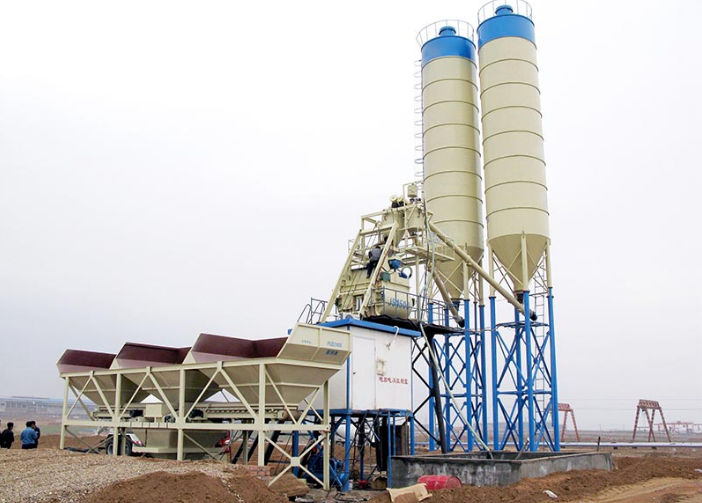Different Types and Features of Concrete Batching Plant
High-quality concrete construction equipment enables efficient completion of construction projects in a shorter timeframe. By reducing labor requirements and delivering superior construction services more quickly, companies can enhance profitability. Advancements in technology have led to the development of a variety of concrete construction equipment options, offering construction firms improved processes and productivity.
A concrete batching plant is a piece of equipment used to blend various ingredients to create concrete. Ingredients commonly used in concrete plants include water, air, admixtures, sand, aggregates (such as rocks and gravel), fly ash, silica fume, slag, and cement. A concrete batching plant can have a variety of parts and accessories, including: mixers (either tilt drum or horizontal or in some cases both), cement batchers, aggregate batchers, conveyors, radial stackers, aggregate bins, cement bins, heaters, chillers, cement silos, batch plant controls, and dust collectors.
How does the concrete batching plant work?
A concrete batching plant, also known as a concrete mixing plant, is a machine designed to blend various materials such as sand, cement, water, etc., to produce concrete.
These ingredients are mixed in different proportions depending on the desired characteristics of the final concrete product required by the company.
The batching plant is a crucial piece of equipment in the construction industry, comprising several essential components including cement and aggregate batchers, aggregate bins, conveyors, mixers, heaters, cement silos, control panels, and dust collectors. The efficiency of the batching plant is paramount for producing high-quality and durable concrete.
Different Types of Concrete Batching Plants Used
Batching equipment employed in conjunction with paving operations often entail additional requirements beyond those specified for other types of concreting operations. Below are several types of concrete batching plants commonly utilized.
Commercial Concrete Batching Plants
A commercial concrete batch plant primarily consists of five main systems: the mixing host, material weighing system, conveying system, storage system, and control system. Designed for commercial purposes, these plants should be efficient, economical, and compliant with environmental protection standards.
Dry Mix Concrete Batching Plant
A dry mix concrete plant, also known as a transit mix plant, utilizes weigh batchers to measure sand, gravel, and cement via digital or manual scales. The ingredients are then discharged into a chute, which leads into a truck. Simultaneously, water is either weighed or volumetrically metered and discharged through the same charging chute into the mixer truck. These components are mixed for a minimum of 70 to 100 revolutions during transportation to the jobsite.
Wet Mix Concrete Batching Plant
A wet mix concrete plant combines some or all of the aforementioned ingredients, including water, at a centralized location into a concrete mixer. This means that the concrete is mixed at a single point and then simply agitated en route to the jobsite to prevent setting, either using agitators or ready-mix trucks, or hauled to the jobsite in an open-bodied dump truck.
Wet mix plants differ from dry mix plants in that wet mix plants contain a central mixer, which can offer a more consistent mixture in a shorter time frame (generally 5 minutes or less). Dry mix plants typically exhibit more break strength standard deviation and variation from load to load due to inconsistencies in mix times, truck blade and drum conditions, traffic conditions, etc.
With a central mix plant, all loads undergo the same mixing action, and there is an initial quality control point when discharging from the central mixer. Some plants combine both dry and wet characteristics for increased production or for seasonal variation.
Mobile Concrete Batching Plant
A mobile concrete batch plant, also referred to as a portable concrete plant, is a highly productive, reliable, and cost-effective piece of equipment for producing concrete batches. It enables users to batch concrete at virtually any location and then move to another site for further batching. Portable plants are particularly suitable for temporary projects or even stationary locations where equipment height is a concern or the required production rate is lower.
Stationary Concrete Batching Plant
The stationary concrete batching plant is engineered to deliver high-quality concrete consistently. It boasts large output, high efficiency, stability, and adherence to strict specifications. With reliable and flexible components, maintenance is straightforward, and the plant exhibits a low failure rate. Widely used in various projects such as roads, bridges, ports, tunnels, dams, and buildings, stationary concrete batching plants are a dependable choice for construction endeavors.
Tower Concrete Mixing Batching Plant
Compared to traditional concrete plants, the aggregates metering system in tower batching plants reduces four intermediate links by transitioning to vertical unloading metering. This method significantly saves measurement time and enhances production efficiency. Tower batching plants are designed based on floor modules or containers, depending on the model. These floor modules and containers are factory-made, including electric installations, enabling rapid installation and commissioning. The aggregate silo volume and quantity can be adjusted according to customer requirements.
Containerized Concrete Batching Plant
The containerized concrete batch plant represents a new type of batching plant, comprising mixing systems, control systems, material storage systems, weighing systems, conveying systems, and others. With features such as a small footprint, quick installation, and convenient transportation, the container mixing plant offers several advantages.
Unlike traditional concrete plants, the container mixing plant eliminates the need for setting legs and mounting brackets, simplifying basic design and construction requirements. It boasts excellent environmental performance, convenient transportation, and straightforward installation. Suitable for various construction projects including hydropower, highways, ports, airports, bridges, and commercial concrete batching plants, the container concrete batching plant is versatile and efficient.
Conclusion
A concrete batching plant can reduce labor costs and boost profits by delivering quality construction services to customers more efficiently. The key lies in selecting the one that best suits your specific requirements.















